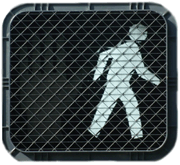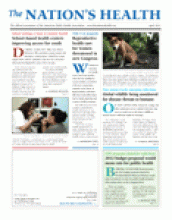Look both ways when you cross the street. It’s advice you heard a thousand times when you were growing up, and have said many times yourself — and for good reason. According to the National Highway Traffic Safety Administration, about 4,100 pedestrians — one every two hours — died in the United States in 2009, and one pedestrian was injured every nine minutes. Equally frightening, after four straight years of steady declines in pedestrian deaths, a report released in January by the Governors Highway Safety Association showed that pedestrian fatalities increased slightly during the first six months of 2010.
With obesity on the rise and more Americans taking to the roads to walk or run, the need to focus on pedestrian safety is great.
Art courtesy iStockphoto. Children by Rich Legg; woman, Leigh Schindler, walk sign, Jason Yoshioka; couple, Yvan Dubé; yellow sign, Sergey Karpov.
“We want people to walk and run and be outside more, but we want to make sure that the roads are safe for them,” says Bella Dinh-Zarr, PhD, MPH, North American director of Make Roads Safe.
Pedestrians — whether they are walking, running, jogging, sitting in strollers or using wheelchairs — are everywhere. Just about every single one of us, the moment we set foot outside, is a pedestrian at some point in the day. Most pedestrian deaths occur at night and in urban settings. Interestingly, only about one in four pedestrian deaths occur in intersections.
The three groups at greatest risk for pedestrian death and injury are people older than 65, children and alcohol-impaired pedestrians. Older people are at highest risk for reasons that include declining vision and reflexes. Also, older people have a harder time recovering from the trauma of being hit by a vehicle. The risk is higher for children for reasons that include difficulty correctly gauging the speed of vehicles and also because they are shorter and not as visible to drivers. According to Safe Kids USA, about 630 child pedestrians die each year in the United States, and 83 percent of child pedestrian deaths occur in places other than intersections.
Alcohol-impairment — either for the driver or for the pedestrian — is reported in about half of the traffic crashes that result in the death of a pedestrian.
“Pedestrians have physical and mental impairments when they are under the influence of alcohol and are at greater risk of being hit by a car,” Dinh-Zarr says. “We are very aware of drunk driving and distracted drivers but we also should be aware of drunk walking and distracted walking.”
By heeding a few simple precautions, you can protect yourself and those you care about from becoming statistics.
Crossing at intersections — where drivers expect pedestrians — is much safer than crossing in the middle, especially on high-speed roads. But don’t proceed until you’ve made eye contact with the driver. And just because the “walk” sign is on, don’t assume you’re safe. A driver may take a right turn into the crosswalk, or might even run the light.
Walk on the sidewalk if one is available, and walk facing oncoming traffic if there isn’t a sidewalk.
At night, visibility is very important. Almost 70 percent of pedestrian deaths occur at night, so wear reflective gear — you might have it on your athletic shoes or jacket already — and carry a flashlight to help drivers see you and avoid hitting you.
“If you have been drinking, these suggestions are even more important, as you might overestimate your capabilities or underestimate the speed of oncoming traffic,” says National Highway Traffic Safety Administration spokesman José Alberto Uclés.
Pay attention while you walk
The No.1 thing pedestrians can do to stay safe is just pay attention. But with a cell phone glued to your ear, lost in a conversation, you might be oblivious to the fact that you’ve just stepped into a busy intersection.
Next time you’re on a busy street, take a look at the number of people walking and talking on cell phones. The problem of talking on cell phones while walking is common and has sparked numerous studies on the dangers posed to pedestrians. One study, published in 2009, concluded that pre-teens’ safety was compromised when distracted by a cell phone conversation. While gabbing, the children were less attentive to traffic, left less safe time between their crossing and the next arriving vehicle and experienced more collisions and close calls with oncoming traffic.
“Just like a driver, pedestrians need to focus when they are on the roads,” Dinh-Zarr says. “Pedestrians don’t have several thousand pounds of metal protecting them and need to be extra vigilant about protecting themselves.”
Be aware behind the wheel
Drivers share the responsibility for preventing pedestrian-related deaths and injuries. NHTSA’s Uclés urges drivers to “slow down and think about who might be out on the road.” The difference between fatality rates of pedestrians increases from just 5 percent at 20 miles per hour to 45 percent at 30 miles per hour, he says.
“When you are going more slowly, you might be able to stop before you hit that person,” he says. “By expecting pedestrians and looking for them, for example in areas near apartment complexes, schools or roadside shops, you increase your chances of seeing them, and of not hitting them.”
>> For more pedestrian safety tips, visit www.nhtsa.gov/pedestrians
- Copyright The Nation’s Health, American Public Health Association














